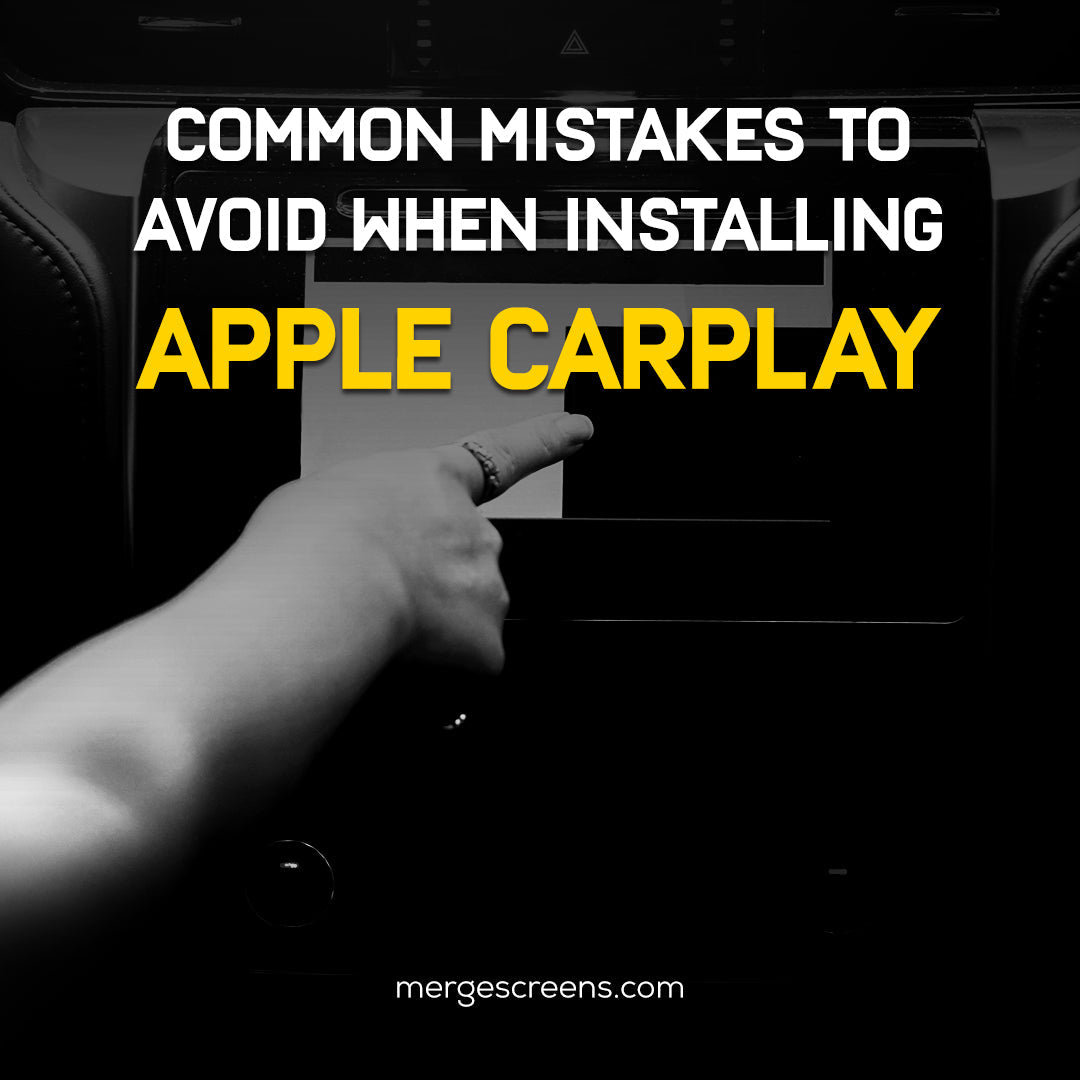Common Mistakes to Avoid When Installing Apple CarPlay

Installing Apple CarPlay in your vehicle is one of the best tech upgrades you can make—it brings iOS features directly to your dashboard. But here’s the catch: many people dive in without understanding the installation process, and that leads to frustrating mistakes, wasted money, and even broken electronics.
If you're planning to do it yourself or just want to understand the process before handing your keys to a pro, this guide will walk you through common mistakes and how to avoid them.
Choosing the Wrong Head Unit
Compatibility Check
Not every head unit is CarPlay-compatible—even if it says it supports iOS. You need to make sure the model specifically supports wired or wireless Apple CarPlay, depending on what you prefer.
Firmware and Model Requirements
Some head units require a firmware update before CarPlay becomes functional. Always check the manufacturer's site before installation.
Ignoring Wiring Harness Compatibility
The Role of the Wiring Harness
Like the brain of your work, the wire harness connects all the parts together.It connects the head unit to the car's power and radio systems. One of the biggest mistakes? Buying a generic harness that doesn't match your vehicle’s make and model.
Mistakes with Universal Kits
Universal kits often require splicing or soldering—risky for beginners. For a clean and safe installation, always use harnesses that are made for your car.
Overlooking Vehicle-Specific Installation Needs
Dashboard Size & Fitment
Head units come in single-DIN and double-DIN sizes. Installing a double-DIN in a car made for single-DIN requires a special mounting kit or trimming the dashboard—which can ruin the aesthetic or fit improperly.
Signal Integration (CAN-Bus, SWC)
Modern cars use CAN-Bus systems to send signals from the steering wheel or sensors to the stereo. You’ll need special adapters to retain these features or else lose functionality.
Skipping the Firmware Updates
Why Firmware is Crucial
Firmware makes ensuring that your device works with the most recent versions of iOS. Skipping this step can cause bugs, lag, or failed CarPlay detection.
How to Check for Updates
Visit the website of the company that made your product and look up your model number. Put the firmware on a USB device and carefully follow the instructions for updating.
Poor Cable Management
USB Connection Errors
A loose or unsupported USB cable can lead to connection drops. Make sure the connection is tight and always use Apple-approved cords.
Tucking and Routing Mistakes
Messy cables can snag, break, or cause shorts. Use zip ties, cable sleeves, and keep wires away from moving parts like pedals or gear levers.
Not Using the Correct Tools
Basic Tools You Should Have
You’ll need:
● Panel removal tools
● Crimpers and wire strippers
● Screwdrivers
● Multimeter for testing connections
Damage Risks from Using Wrong Tools
Using a butter knife to pop panels? That’s a fast way to crack plastic or scratch the dashboard.
Ignoring Audio and Microphone Quality
Built-in Mic vs. External Mic
Factory-installed mics are often low quality. Using a high-quality external mic, placed closer to the driver, improves Siri recognition and call clarity.
Balancing Audio Input/Output
If audio sounds too low or too distorted, you may need to tweak settings on both the head unit and the car’s amp or speakers.
Forgetting About Wi-Fi and Bluetooth Settings
Initial Pairing Confusion
If you’re setting up wireless CarPlay, make sure to pair Bluetooth AND connect to the Wi-Fi network of the head unit.
Conflicting Devices
Your iPhone may try to connect to more than one Bluetooth device. Disconnect or “forget” unused ones for a more stable connection.
Failure to Follow Instructions
Relying Solely on YouTube
Videos on YouTube can be helpful, but they might not always be relevant to your car or setting. Always read the full instruction manual.
Not Reading the Manual Thoroughly
It might be boring, but the manual contains crucial steps, safety precautions, and wiring diagrams.
Installing in Older Vehicles Without a Plan
Power Draw Issues
Older cars may not have the juice to support a CarPlay unit, especially if it's a touchscreen model. You may need to get a new battery or alternator.
Integration With Factory Systems
If your car has built-in amps or proprietary sound systems, you’ll need special adapters or bypass modules.
Skipping a Backup Camera or Retaining Factory Features
Important Add-ons
Don’t just focus on CarPlay—adding a backup camera or parking sensors during installation saves labor costs and improves safety.
Steering Wheel Controls and Sensors
Use SWC adapters to retain your steering wheel volume, voice command, or call buttons.
Underestimating the Time Needed
Installation Isn’t a 10-Minute Job
Depending on your skill level and vehicle, this could take 2–5 hours or more.
Common Delays
Issues like incorrect harnesses, lost screws, or firmware problems can delay the process.
Troubleshooting Mistakes
Ignoring Error Codes
Many head units display error messages for USB issues, firmware mismatch, or failed connections. Don't disregard them; look them up on Google or in the handbook.
Resetting and Diagnostics Tips
If all else fails, reset your unit to factory settings, disconnect your iPhone, and try the pairing process again.
When to Hire a Professional
Signs You Need Expert Help
● No prior installation experience
● Complicated vehicle wiring
● Losing factory features
What Professional Installation Includes
Pros provide:
● Wiring diagrams
● Panel-safe tool use
● Factory feature retention
● Warranties on labor
For a complete breakdown on how to properly install Apple CarPlay—including tools and steps—we recommend checking out this guide on how to install CarPlay. It’s a must-read if you're still unsure whether to DIY or go pro.
Real User Experiences and What They Teach Us
DIY Wins and Fails
Some users install it smoothly with online tutorials, while others struggle for hours only to find out they missed one wire.
Lessons Learned From the Community
● Always test before buttoning up
● Update firmware before wiring
● Triple-check compatibility
Final Thoughts
Installing Apple CarPlay isn’t rocket science—but it’s not plug-and-play either. If you avoid the common mistakes outlined here, you’ll have a smoother, safer, and more functional setup. Whether you go full-DIY or choose professional help, the end result should be a modern driving experience that keeps you connected and focused on the road.
FAQs
1. Can I install Apple CarPlay myself?
Yes, if you have basic technical skills, tools, and time. Just be sure to research your car’s specs and follow instructions carefully.
2. How much does professional CarPlay installation cost?
Costs vary by location and vehicle but expect to pay $150–$500 for labor alone.
3. Do I need a new stereo for CarPlay?
Yes. Your existing stereo must support Apple CarPlay or be replaced with a compatible one.
4. Why is my CarPlay not connecting after installation?
Common reasons include firmware issues, USB cable problems, or incomplete pairing settings.
5. Can older vehicles use Apple CarPlay?
Absolutely. As long as there's enough space and the right power supply, any car can be upgraded with the right components.

